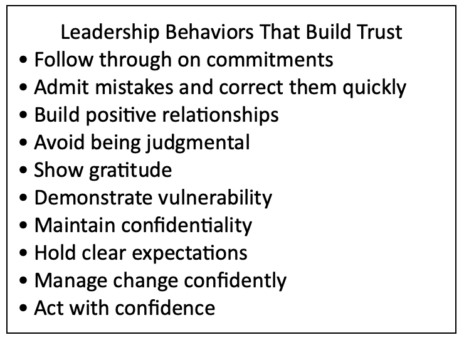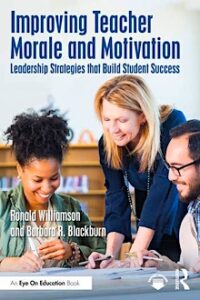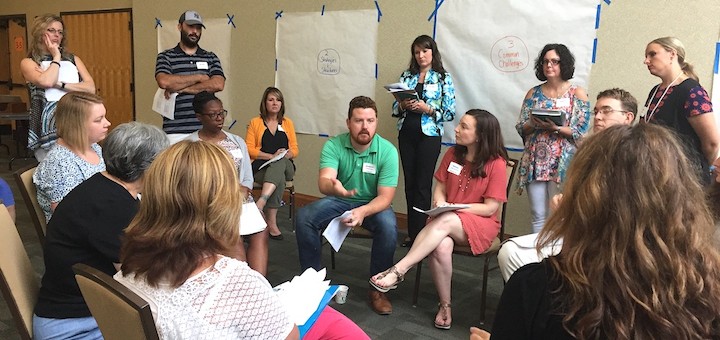By Ronald Williamson and Barbara R. Blackburn


It’s an understatement to say we live in uncertain times. But the fact is that schools, like many of our nation’s institutions, are experiencing the impact of political change at a dramatic and often confusing level.
The pace is frantic and it feels never ending. Between the time this post is written and published it’s likely that even more uncertainty will be introduced.


Change is always difficult. People react in starkly different ways. Schools are intensely “people” focused, and that means the disruption destabilizes both employees and the families and community they serve.
As DEI programs are dismantled and funding for school nutrition and professional development ends, there’s an immediate reaction from those affected. The end of support for community health programs, museums and cultural institutions, and others impacts the larger community.
It’s even more disconcerting when changes seem to cascade with no indication when they may stop. Often there is little clarity about actual changes, the extent they will impact schools, or the timeline for resolving unanswered questions. This uncertainty creates an environment that distracts and disrupts.
How does a leader respond? How does a leader provide certainty and stability in the midst of great uncertainty? How does a leader support their staff and community, so that the educational experience of students is not negatively impacted?
What Leaders Can Do
Skillful leaders are empathetic, show compassion for others, and respect differences of opinion. They also work to overcome challenges with curiosity and a willingness to learn and grow. They accept stress as part of life and avoid getting caught up in the chaos that uncertainty and change can bring.
Our own work with teachers and school leaders often deals with change. From that experience we’ve identified five ways leaders can support their staff, build confidence in the future, and reduce the anxiety associated with the unknown of unanticipated change.
1. Model Calm and Confidence
One thing is very clear. Leaders are role models, and people look to them for guidance, especially during uncertain times. Basically, you want to remain unflustered, self-assured and model how you want your staff to respond. Flustered teachers often mean flustered students.
A leader’s behavior impacts those around them. Being calm and self-assured inspires trust and provides a sense of stability for teachers and community. That’s a benefit especially in uncertain times like schools are experiencing today.
Being calm also allows for clearer thinking, leading to better decision-making. It also reduces stress for you, and those in your school community, and helps to promote resiliency or the ability to bounce back from stressful situations.
Remaining calm doesn’t mean you ignore the obvious strain on your school, or you lack clarity about what to do. But not reacting to those stressors helps you and your staff develop a plan for responding that aligns with your vision and supports your employees and your students.
Here are some things we’ve found that can support calmness when feeling stress and anxiety.
- Focus on the present and what you can do. Avoid excessive thinking about “what ifs” and what else may change.
- Expect the best, not the worst. Imagine that the changes are playing out positively and that you and your staff will handle the change smoothly and confidently.
- Accept your feelings. It’s okay to feel stressed. It’s okay to get angry. That’s part of a natural reaction to change. Accept how you feel but don’t let those feelings drive your behavior. Address stress in a healthy way by acknowledging and processing it.
- Maintain a healthy lifestyle. It’s been said often, but get exercise, maintain a balanced diet, and get sufficient sleep. Those things help provide stability and keep you calm.
2. Provide Open and Transparent Communication
When change occurs quickly, people immediately crave information. If you, as the leader, don’t provide it, people will seek it elsewhere. It’s best that you become the source for accurate and up-to-date information.
Be Open and Honest
Recognize that communication flows both ways. Share information but take every opportunity to listen to others, to identify their questions and concerns, and to help you shape your communication strategy.
It’s likely that you don’t have answers for every concern. It’s okay to say that and to propose a timeline for gathering an answer. Never knowingly conceal information that’s vital to your school community. Honestly describe the circumstances and what you know.

 Be respectful. Every school community has people with different points of view. Listen carefully. Ask questions of clarification. There’s no need to respond to things with which you may disagree. Be extra careful when using social media to share information.
Be respectful. Every school community has people with different points of view. Listen carefully. Ask questions of clarification. There’s no need to respond to things with which you may disagree. Be extra careful when using social media to share information.
Finally, empathy helps a lot. Show that you understand where people are coming from. Express your own feelings and show a willingness to support your school community. Be sensitive to the strain of change on individuals and your school organization. That’s why holding a “listening session” where you briefly share information but spend the bulk of the time listening to concerns can be helpful.
During stressful times people need to be around others and to talk about the issues. Such sessions can also help you identify underlying issues that may be troubling your school or community.
Be Clear and Concise
Communication is best when it’s clearly and concisely presented. Social media has shaped how we get information, and short posts are common.
When sharing information about significant change, it may be best to use a combination of face-to-face meetings and social media. A face-to-face meeting allows for greater, and often faster, response. Meeting in small groups, or individually provides a more personal setting and creates a safe space for people to talk. Social media postings often lead to responses that may be posted by people without accurate or timely information.
There are often limits to what can be shared. Ron worked for a Superintendent who expected administrators to always be able to explain why they did something or chose an option. That’s critical when you can’t share something fully. Honesty about limits helps build trust and manage expectations.
Regardless of the medium, your message should be concise. Long messages or speeches tend to be discounted. People either move on or tune out. Deliver the message and then provide time for people to ask questions or comment.
Accept Accountability
When change occurs quickly, there’s often a lot of disinformation. That’s especially true with social media. Don’t add to that. Make sure information you share is accurate, but if it’s not, or if things change, quickly accept responsibility and correct the misinformation.
It’s often critical to let people know that the information you have will probably change quickly and at any time. But that message is often not heard. Don’t be critical if it’s missed. Just don’t get defensive. Don’t blame others. Be accountable. Make the correction or addition, and move on. Commit to sharing information as quickly as it becomes available even if it contradicts previous thinking.
3. Stay Focused on the Shared Vision and Values
Change creates stress on a school and community, especially when it affects core beliefs like equity and inclusion. Thousands of schools include some version of those terms in their vision statements.
Mandates from the federal government to remove those terms and end programs are often debilitating. But they can’t detract from a school’s core values and shared vision. Behind those terms is a commitment to serve students and to provide the very best educational experience for each student.
There’s often a rush to make changes and adjustments – a rush to comply. And that may be necessary, but beyond those modifications there’s also a need to figure out how to continue to provide for the needs of each student and support core values.
The words in published vision statements may change, and programs may take on different names, but the beliefs and actions of individuals don’t need to change. School leaders still make decisions about who to hire. They select curricular and instructional materials. They decide how to allocate budget resources, and they develop daily and weekly schedules that serve students.
One way a leader supports and addresses uncertainty among their teachers and school community is by working together to revisit – and affirm – the mission and vision, to recommit to the core values underlying its message, and to develop strategies for schools to continue to be warm, caring, and welcoming places for every student, every family, and every employee.
4. Maintain Trust
Trust is always cited as one of the most critical leadership traits and is absolutely essential during significant change or stress at a school. When trust is present, people are generally more productive, more satisfied with their job, and more likely to put in more discretionary effort. A trusted school is also a place where people are more committed to working collaboratively on behalf of students and their learning.
What a leader does, what they say, and how they spend their time signals what is important and what they value. Here are ten leadership behaviors that build, and sustain, trust.

 When times are uncertain, trust is essential. Employees and community need to know they can rely on their leader for accurate and timely information.
When times are uncertain, trust is essential. Employees and community need to know they can rely on their leader for accurate and timely information.
5. Encourage Collaboration and Value Input
A collaborative school is a natural extension of a school where trust is present. Collaboration improves decisions, empowers employees, and allows everyone to build ownership for the school’s program.
In uncertain times it’s often seductive to minimize collaboration and to simply act to address the issue or concern. Doing so undermines trust, reduces respect for you as a leader, and often adds stress to everyone involved.
Uncertainty calls for a collaborative response. Encourage teachers and community to get involved. Provide opportunity for people to share their thoughts. Listen attentively but avoid committing to strategies that you are unsure will address the problem. Encourage involvement of people who hold different points of view and perspectives.
Final Thoughts
We are living and working in an uncertain time, and the stress on our social institutions, including schools, is significant. Leaders play a critical role in helping their school community weather the changes and continue the long-standing commitment to serving each and every student with the very best educational program.
References
Butler, R. (2023). Three principles of transparent communication., Forbes. Retrieved online April 5, 2025 from https://www.forbes.com/councils/forbesbusinesscouncil/2023/06/29/three-principles-of-transparent-communication/
Clark, T. (2024). What employees need from leaders in uncertain times. Harvard Business Review. Retrieved online from https://hbr.org/2024/02/what-employees-need-from-leaders-in-uncertain-times
Lawrence, T. (2025). Leading through uncertainty: Leadership in challenging times. Forbes. Retrieved online from https://www.forbes.com/sites/tracylawrence/2025/02/24/leading-through-uncertainty–leadership-in-challenging-times/
Turing (2022). Top 10 strategies for leading through uncertainty. Retrieved online from https://www.turing.com/resources/10-strategies-for-leading-through-uncertainty
Williamson, R. & Blackburn, B. R. Improving teacher morale and motivation: Leadership strategies that build student success. New York: Routledge/Eye On Education.

 Dr. Ronald Williamson is Professor Emeritus of Educational Leadership at Eastern Michigan University. He is a former principal, central office administrator and executive director of the National Middle School Association (now AMLE). The author of numerous books on leadership, Ron is the co-author with Barbara R. Blackburn of 7 Strategies for Improving Your School (2019) and Improving Teacher Morale and Motivation: Leadership Strategies that Build Student Success (2024), both from Routledge/Eye On Education.
Dr. Ronald Williamson is Professor Emeritus of Educational Leadership at Eastern Michigan University. He is a former principal, central office administrator and executive director of the National Middle School Association (now AMLE). The author of numerous books on leadership, Ron is the co-author with Barbara R. Blackburn of 7 Strategies for Improving Your School (2019) and Improving Teacher Morale and Motivation: Leadership Strategies that Build Student Success (2024), both from Routledge/Eye On Education.
Dr. Barbara R. Blackburn, a “Top 10 Global Guru in Education,” is a bestselling author of over 30 books and a sought-after consultant. She was an award-winning professor at Winthrop University and has taught students of all ages. In addition to speaking at conferences worldwide, she regularly presents virtual and on-site workshops for teachers and administrators.
Barbara is also the author of Scaffolding for Success (Routledge/Eye On Education, 2025) and many other books and articles about teaching and leadership. Visit her website and see some of her most popular MiddleWeb articles about effective teaching here.









